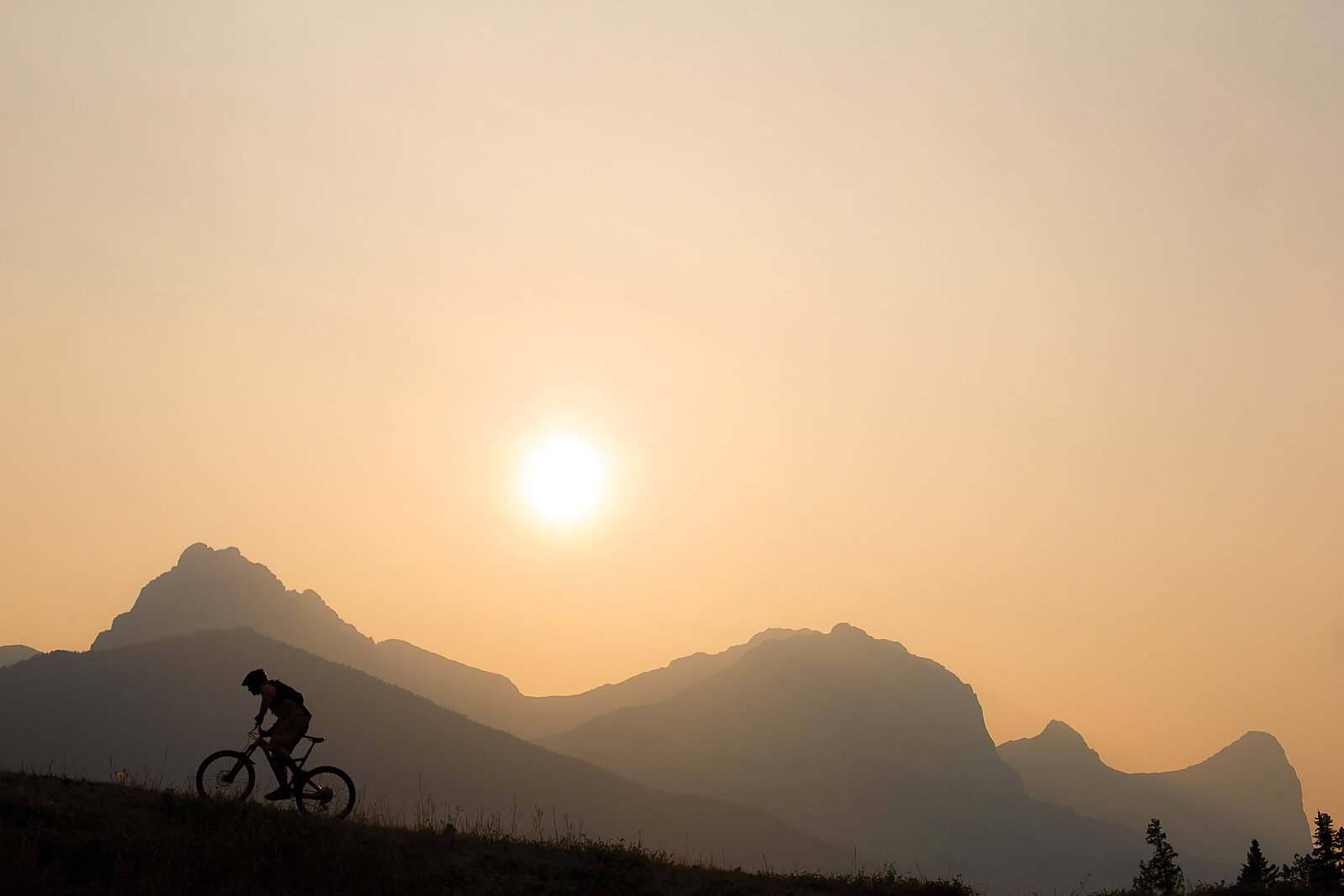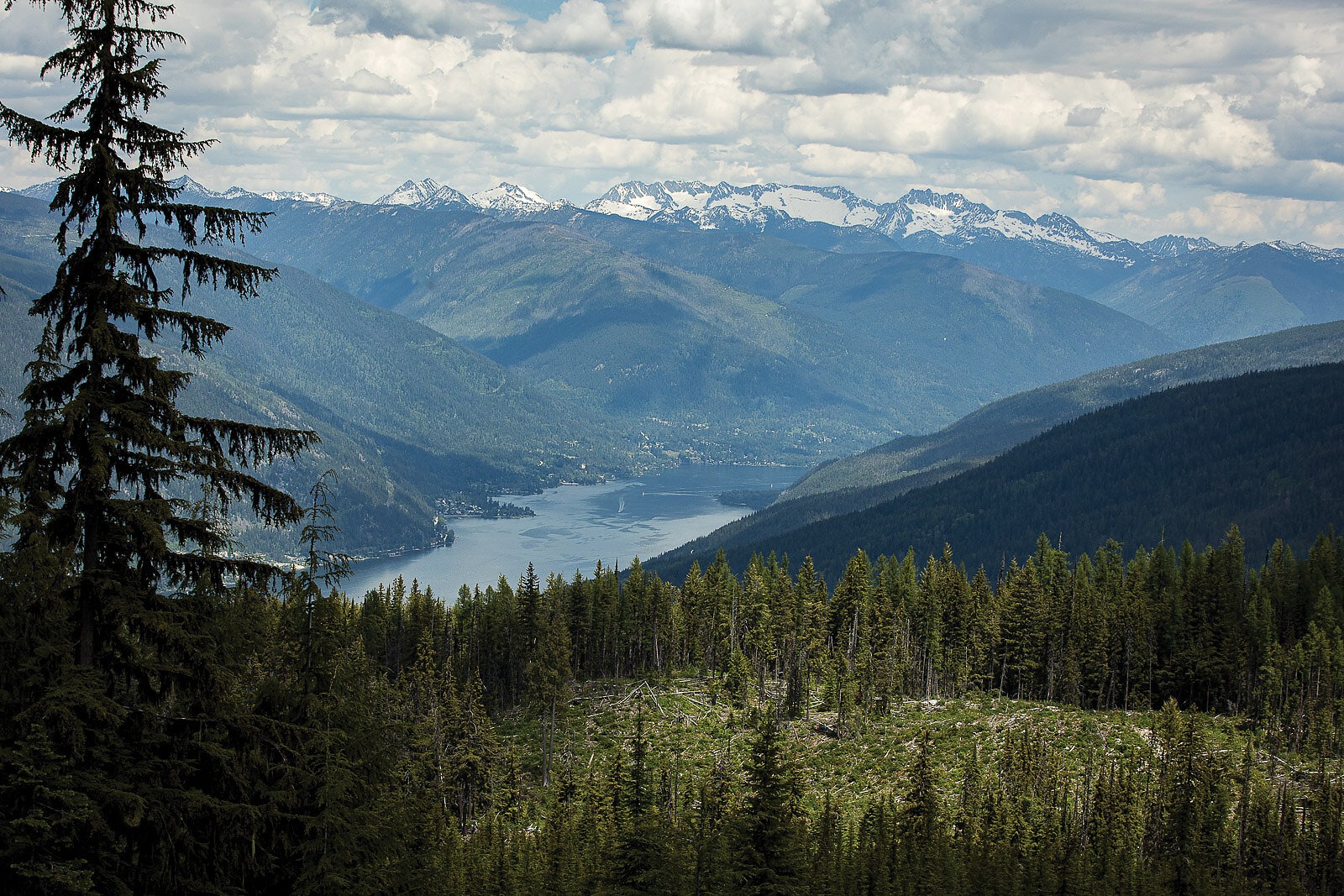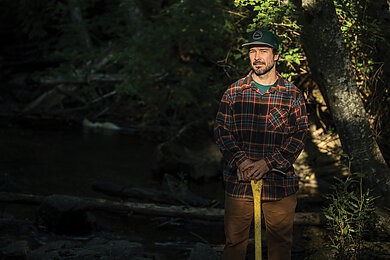
Racing the Climate Canadian Event Organizers Feel the Heat
Words by Matt Coté
Harry Utsal is tall and skinny, making the coil-sprung 29’er underneath him look like a play bike. He maneuvers it with the kind of leverage that long limbs obscure—subtle corrections and weight shifts are mostly imperceptible but add up to microseconds, then seconds, then minutes at the end of the day. Except no one’s timing him.
“Man, I wish there was still a race here,” says Utsal as he collects himself under the canopy of a giant cedar tree on Revelstoke, British Columbia’s Boulder Mountain.
A graphic designer by day and a new dad, Utsal started racing enduros only a few seasons ago. He’s done the Kamloops stop of the Canadian Enduro League (CEL) at Harper Mountain three times, and the Revelstoke edition only once. He was looking forward to competing at home again this summer on his local trails after an injury last season, but the CEL isn’t coming back.
After 221 racers tested their mettle down Boondocker in 2023—a showpiece gravity trail for the town—it barely rained for almost three months, rendering the trail near impossible to rehabilitate from the race’s heavy wear. Environment Canada recorded just 3.5 inches between June and July of that year, when normal would be 10. Revelstoke sits in a wet belt that has a near-identical climate to the Pacific Northwest. This rare inland version of a coastal ecosystem runs 385 miles north from the U.S. border up into the continental plateau near the city of Prince George. It’s part of what gives Canada’s westernmost province its lore as a mountain bike destination.


The B.C. Ministry of Forests calls this the interior cedar-hemlock zone, or ICH for short, and it’s changing. As years of drought pile up, trees are dying, and trails are disintegrating. What once was loam is quickly becoming foot-deep trenches of moondust that disappears into the atmosphere when shralped, rendering races ever more taxing. This reality has become increasingly prescient to local clubs, who’ve begun saying “no” when asked to host larger events.
That rub is creating a conundrum for many mountain bikers who view racing as an inextricable part of the sport’s culture. Be it on foot or bike, there is something innately human about seeing how fast you can go. And on a social level, for many, racing is a way to build community, visit other riding zones, or share your own.
“It would be sick to see how well I shape up on trails that I ride every week,” Utsal says. “And I’d love to get to show my buddies from the Coast all the cheeky lines and the home turf. It’s kind of like … you feel a little proud of that, you know?”
The CEL stop in Revelstoke was indeed a beloved event. But when organizers asked the Revelstoke Cycling Association (RCA) if they could come back in 2024, the RCA only offered the shoulder season, strictly excluding July or August as options.
“We did want [the race] back,” says Alex Cooper, the RCA’s executive director. “But we want to do it in the spring or fall when there’s more moisture in the ground and less impact on the trails so our members and other visitors to our community can enjoy them afterward.”
Notably, the RCA is still holding its own annual women’s enduro in early September, with one stage on Boulder Mountain. September is, for now, generally wetter.
Cooper describes a great relationship with the CEL, which he says has always infused a generous amount of cash directly back into the club. The problem isn’t the organizers, but the fact that no amount of money can fix trails with no moisture in them during drought months. Unfortunately, the characteristics that make temperate forests so perfect for mountain biking are the same ones that make them so vulnerable to climate change.


“Generally, the big theme is that these hotter and drier ecosystems are going to expand,” says Conor Corbett, a registered professional forester and mountain biker who writes wildfire prevention plans for many of B.C.’s outdoor recreation communities. He says the fringes of biogeoclimatic ecosystem classifications are constantly shifting now, and the boundaries of the ICH zone—where Revelstoke sits—are on the front lines of that change.
That’s a problem for mountain biking because the ICH zone has coarse-textured soils without a lot of clay. These soils drain well but, as trees die off, canopy disappears and moisture becomes less prevalent. Soils adapted to wetter forests don’t stand a chance against tires. This phenomenon is clearly on display in areas where trails go through clearcuts, Corbett adds.
“Anything that’s in a soil-based substrate will get really blown out under the hotter and drier conditions expected with climate change,” he says. “These types of ecosystem shifts usually happen over a very long timeline, like hundreds to thousands of years, and this is happening at such an accelerated rate.”
Indeed, event organizers are having to adapt to new trail-condition regimes almost overnight.
For those waiting for snow to melt into mid-June, July, and August, it is tough to take off the table. If September is the earliest option for an event, organizers must contend with shorter daylight hours. It’s a tough equation.
The CEL’s schedule dropped from nine to four races in 2024. The organization declined to comment on whether that was due to difficulty finding venues or other factors, but several other race operators did go on the record to confirm that they have had a harder time getting land permissions for those months.

Aaron McConnell is one of them—he’s president of the TransRockies Race Series, which has been operating for 20 years and puts on 10 riding and running events across North America annually. That includes a notorious six-day stage race called the Singletrack 6, which visits a different community in B.C.’s Kootenay region each day of the race. McConnell says TransRockies has been around long enough that they’re not without partner communities to work with, but it’s more complicated than it used to be.
“Rossland basically said the same thing to us, nothing in July or August,” McConnell says. “We were there a couple years ago in September and haven’t gone back so far. We were in Castlegar for one stage this year, and they said before July 13, so we were just a couple days before that.”
McConnell says there are workarounds in the form of less-developed communities trying to get in on the bike boom. The 1,000-person hamlet of Kaslo in B.C.’s West Kootenay is a good example, where the trail managers are very interested in promoting their growing network and hosted a Singletrack 6 stage on July 14. As some towns blow out, others open up.
Even so, the Singletrack 6 took place during a record heat wave this year, only days before much of the West Kootenay caught fire. For promoters, the problem is layered. Even if you can strike a deal, will the climate support a mid-summer race? Excessive heat and wildfires combine to create an unpredictable list of risks. In 2023, TransRockies was forced to cancel a gravel event because of a wildfire. Attendees had traveled to be there, vendors and third-party contractors were in place; it all added up to a lot of sunk costs.

A 2024 survey titled Extreme Weather and Event Planning in Canada found this wasn’t an isolated event, and that “72 unique events were reported as disrupted by heat, wildfire, flooding, cold and storms in Canada in 2023 … [with] nearly half of reported disruptions in British Columbia.”
Another study out of Thompson Rivers University that focused more specifically on mountain biking had similar findings. In it, authors Courtney W. Mason and Pate Neumann wrote: “While the timing, availability, and demand for trail-based sport and recreation experiences are predicted to increase, research demonstrates that the visitor-related environmental pressures will become more severe with longer, drier, and hotter summers. According to a recent Environment and Climate Change Canada report, Canada is warming at a more rapid rate when compared to global averages.”
Since completing his master’s degree in 2023, Neumann has gone on to specialize in building climate-resilient trails. He now lives in Kaslo where he’s helping build up the bike scene. He believes the main problem climate change poses to trail clubs is that it exacerbates a lack of resources and funding for most of them.
“In communities that I’ve been a part of, the big question that comes back [about races] is, ‘What’s in it for us?’” Neumann says. “I think a lot of these big events are not going to be asked back to these communities until they feel they have a kind of robust maintenance program that can actually bring their trails into shape to handle that amount of use.”
Neumann is, however, emphatic that where new builds are concerned, trail design can mitigate a lot of these issues. It costs more upfront to dig a modern trail that uses better grades, is armored, and taps the most resilient features on the ground, like rock slabs. But it’s still cheaper in the end because it prevents having to completely rebuild later.
One solution that gravity-based race organizers are pursuing is to partner with bike parks, since they tend to have modern trails built to sustain heavy volume. They also have lifts, trail crews, restaurants, and other resources, which means organizers don’t have to contract as much work out to third parties. Still, bike parks create other challenges. Lift access means racers can get in more practice laps, which has its own exponential effect on the track.
At Kicking Horse Mountain Resort’s bike park, which has been hosting Canada Cup and B.C. Cup downhill events for nearly two decades, the trail crew often must repair berms and blown-out features nightly as racers practice. If there’s any doubt that racing has a higher impact than regular riding—even in a bike park—Sean Nyilassy puts those to rest.


“If you’ve been here long enough and you’re biking or walking the [racetrack], you can see the old sections that are knee-deep trenches, and just no longer feasible to keep open,” he says.
Nyilassy is the summer safety manager at Kicking Horse and has worked in the park for 16 years. He says the fairly constant rerouting of the course is good in one sense, as racers love the new sections year over year, but it is a major labor that pulls time away from the rest of the park.
“Hopefully it’s a positive thing that people who come here tell their friends about and it helps build our business,” he says. “But, at the same time, it’s a lot on our team and our resources to host events of that size and maintain the mountain after all those riders leave.”
Nyilassy expresses the same stresses that race organizers do—as the race gets pushed earlier and earlier into the season, the trail crew is pressed up against snow melt to prep the course while also getting the rest of the park ready for the public.
He says that a more pressing issue, however, is that wildfire smoke and heat are becoming increasingly difficult factors to account for when it comes to staff, volunteer, and rider safety. How hot is it too hot to hold a race? How much is too much fine particulate matter in the air? The closest Air Quality Index (AQI) sensor is far from Golden and smoke can be very localized. Official guidance is virtually nonexistent and Worksafe B.C. doesn’t offer clear rules.
McConnell and TransRockies, for their part, say the pandemic forced them to think about cancellation policies and they now have their own AQI threshold for cancellation. They haven’t had to use it yet, but he knows the day is coming.
“We’ll definitely take a hit,” he says. “But it’s not necessarily our whole year, so that does help. And if the event is not sold out, we have the opportunity to make some of that back—we typically just roll everyone over and give them a full free entry for the next year, and then we can sell some additional entries as well.”
But McConnell knows that’s a very different proposal for companies with less events. Most do not have weather windows or cancellation policies for this reason (though racers can often buy their own cancellation insurance). Some local trail clubs are considering adding their own cancellation policies into event contracts, adding more potential headaches for race organizers.


A multi-day event such as the weeklong BC Bike Race, for example, has little ability to shift its schedule. July and August are when most people have enough time off to race an event that takes a whole week. The iconic race has taken place on Vancouver Island’s east side in recent years, which, despite a coastal climate, is also only getting hotter and drier.
“We don’t want to be on the trails in the dust anymore than the clubs want us to be there,” says Andreas Hestler, who co-owns BC Bike Race. “It’s not as fun, and particularly when the summer is hot it makes no sense. But we don’t want to ride through the deepest, darkest, wet mud puddles of winter either, because again, it’s not fun to ride. So it’s about finding a sweet spot, and we’re all looking, watching, calculating.”
Part of that calculation, for any race organizer, is cost. Some clubs are savvy enough to make the commercial fee for using their trails contingent on a pre-and post-race inspection. Only after they’ve seen the damage to a course will the club name its price. Nyilassy believes the ones that do it this way are clever because he’s seen more and more of his budget at Kicking Horse sink into maintaining its racecourse, and he knows clubs—many of which operate as nonprofits—are stretched even thinner.
“Dry is almost worse than wet,” McConnell says, explaining that TransRockies’ per-racer fee for trail clubs has tripled in recent years, from $5 to $15 per rider. He doesn’t necessarily think that means the trails are suffering three times more damage, but clubs are expecting more labor for every race run and adjusting their pricing accordingly. Numbers aside, all parties agree that racing has tremendous social value. Revelstoke’s Cooper insists that these less-tangible impacts have to be taken into account when considering an event’s total value. Tourism helps secure funding in the form of grants, so outside visitors do in fact help local riders.
That’s a paradigm that the Whistler Off Road Cycling Association (WORCA) figured out a long time ago. As the most frenzied mountain bike town in the world, Whistler has been dealing with blown-out trails for what feels like forever. And while the climate is changing there too, WORCA has managed to get out ahead of the race issue with some clever planning—not to mention a hefty amount of funding from the Resort Municipality of Whistler. The town gives the club $282,450 a year to maintain trails for their tourism value alongside the club’s duty to locals.
As such, WORCA doesn’t have an event cancellation policy baked into its contracts and tries its best to be open for business to races. It does that with a rotating list of pre-approved trails that have been armored and built up to purposefully withstand heavy use. Trails not on that list are simply unavailable to race organizers.


“Not to throw any event organizers under the bus,” says Dan Raymond, WORCA’s lead trailbuilder, “but there are less-known mountain bike destinations that are very happy to host an event to get some exposure … and the racers love it. But then that event doesn’t leave behind enough of a [financial] legacy to maintain those trails, and then they move on to another community and do the same thing. That’s something that we saw coming pretty quick with the advent of more and more races as part of Crankworx that were spreading out of the bike park. There were a few years of difficulty when the impacts weren’t matching how much we were getting, and now I think we’ve found a pretty good balance for being able to justify the cost of hosting an event on our trails, given the amount of work that they’re going to need afterwards.”
One of the inciting factors was when the Enduro World Series raced Pura Vida on Whistler’s west side. The dirt vaporized between the roots and left holes the size of basketballs on a trail that was once famous for its natural flow. WORCA had to haul in huge rocks to fill the gaps and the trail was forever changed.
“Often, when we’re trying to renovate a trail, we’re trying to bring it back to its condition in its early years,” Raymond says. “But hosting an event on a trail just ages it. When it came to Pura Vida, locals were really upset that it would never be the same.”
Raymond also notes that the impact on the surrounding forest from spectators was a big issue too, as it trampled the understory. He says in some cases it caused as much trail creep as racers cutting corners. Concentrating those impacts on trails already affected by heavy traffic has been the best mitigation and has proven to work for WORCA. Trails already pummeled by racing make great sacrificial lambs. Once armored, they have a dedicated purpose and require a lot less maintenance. Raymond says the first time a trail is raced it will always need more maintenance than the third or fourth time.
Of course, an inventory of hundreds of the world’s best trails is an asset that most communities can only dream of. WORCA’s annual operating budget of $720,000 gives it resources that lesser-known locales can’t match. Back in Revelstoke, Utsal hopes there’s some kind of intermediary solution that doesn’t take that kind of money or buy-in. The RCA’s budget is only $170,000, and it’ll be a long time before it can do what WORCA does. Utsal knows that intuitively. He also knows he’s finished in second and fourth place in his category at Harper Mountain the last couple years, and he wants to race more. As temperatures climb, wildfire smoke moves in, and trails turn to dust, he is patiently waiting for a second chance to stand on the top step of the podium in the place where it would mean the most to him—his home community.


